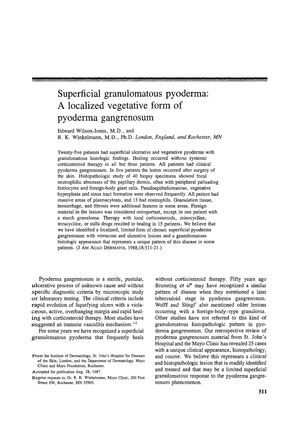Superficial Granulomatous Pyoderma: A Localized Vegetative Form of Pyoderma Gangrenosum
March 1988
in “
Journal of The American Academy of Dermatology
”

TLDR Superficial granulomatous pyoderma is a unique, mild form of skin disease that often heals without strong medication and responds well to milder treatments.
In 1988, Wilson-Jones and Winkelmann conducted a study on 25 patients with superficial granulomatous pyoderma, a localized vegetative form of pyoderma gangrenosum. The study found that the majority of patients (22 out of 25) healed without systemic corticosteroid therapy and that the lesions often appeared post-skin surgery. Histopathological analysis of 40 biopsy specimens showed characteristics such as focal neutrophilic abscesses, peripheral palisading histiocytes, foreign-body giant cells, and plasmacytosis in all patients. Treatments with local corticosteroids, minocycline, tetracycline, or sulfa drugs were effective in 15 patients. The study concluded that superficial granulomatous pyoderma is a distinct clinical and histopathological pattern of pyoderma gangrenosum, which is limited, superficial, and granulomatous, often occurring without systemic disease and responding to conservative medical treatment. Additionally, the document briefly mentions dermatological reactions to minoxidil and isotretinoin, as well as the dermatological relevance of adult T-cell leukemia.
